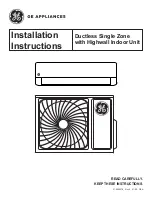
Page 14
CHECKING AND ADDING SYSTEM
REFRIGERANT
The 13ACX unit is factory-charged with enough HFC-410A
refrigerant to accommodate a 15-foot length of refrigerant
piping. Charge should be checked and adjusted using the
tables provided on the charging procedure sticker located on
the unit access panel. Detailed information is provided in the
13ACX Installation and Service Procedures manual
(Corp0625-L5), which is available on DaveNet.
Homeowners Information
CAUTION
Before attempting to perform any service or mainte
nance, turn the electrical power to unit OFF at discon
nect switch.
Cleaning of the outdoor unit's coil should be performed by a
licensed professional service technician (or equivalent).
Contact your dealer and set up a schedule (preferably twice
a year, but at least once a year) to inspect and service your
outdoor unit. The following maintenance may be performed
by the homeowner.
Outdoor Coil
The outdoor unit must be properly maintained to ensure its
proper operation.
S
Please contact your dealer to schedule proper inspection
and maintenance for your equipment.
S
Make sure no obstructions restrict airflow to the outdoor
unit.
S
Grass clippings, leaves, or shrubs crowding the unit can
cause the unit to work harder and use more energy.
S
Keep shrubbery trimmed away from the unit and
periodically check for debris which collects around the
unit.
S
Keep snow level below the louvered panels to ensure
proper performance.
IMPORTANT !
Sprinklers and soaker hoses should not be installed
where they could cause prolonged exposure to the
outdoor unit by treated water. Prolonged exposure of
the unit to treated water (i.e., sprinkler systems, soak
ers, waste water, etc.) will corrode the surface of steel
and aluminum parts, diminish performance and af
fect longevity of the unit.
Routine Maintenance
In order to ensure peak performance, your system must be
properly maintained. Clogged filters and blocked airflow
prevent your unit from operating at its most efficient level.
NOTE
—
The filter and all access panels must be in place
any time the unit is in operation. If you are unsure about the
filter required for your system, call your Lennox dealer for
assistance.
1. Ask your Lennox dealer to show you where your indoor
unit's filter is located. It will be either at the indoor unit
(installed internal or external to the cabinet) or behind a
return air grille in the wall or ceiling. Check the filter
monthly and clean or replace it as needed.
2. Disposable filters should be replaced with a filter of the
same type and size.
3. The indoor evaporator coil is equipped with a drain pan
to collect condensate formed as your system removes
humidity from the inside air. Have your dealer show you
the location of the drain line and how to check for
obstructions. (This would also apply to an auxiliary
drain, if installed.)
Thermostat Operation
See the ComfortSense
®
7000 thermostat homeowner
manual for instructions on how to operate your thermostat.
Preservice Check
If your system fails to operate, check the following before
calling for service:
S
Verify room thermostat settings are correct.
S
Verify that all electrical disconnect switches are ON.
S
Check for any blown fuses or tripped circuit breakers.
S
Verify unit access panels are in place.
S
Verify air filter is clean.
S
If service is needed, locate and write down the unit
model number and have it handy before calling.

































